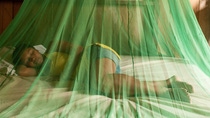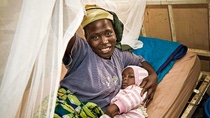Chi siamo
Net value

Nearly 165 million mosquito nets made by different producers were supplied to malaria zones in 2010 – with around 145 million going to sub-Saharan Africa alone. The percentage of at-risk households owning at least one net has risen from 3% in 2000 to 50% in 2011. According to the World Health Organization (WHO), as long as there is no effective vaccine against malaria, mosquito nets will continue to be a decisive tool in malaria control.
To meet WHO recommendations, nets must last for three years and 20 washes and contain an insecticide that kills mosquitoes after brief contact – such as BASF's mosquito net Interceptor®. It is thus recommended by the WHO as a “long-lasting insecticide-treated net" – or LLIN.
The nets are most effective when used in combination with other malaria control products. Dr. Egon Weinmüller, Head of the Public Health business at BASF, explains that collaboration between the private sector and aid organizations is also essential: "For instance, we work very closely with aid organizations who distribute the nets as they are crucial in supporting the process on-site."
While ordinary nets will keep mosquitoes at bay, they won’t prevent them biting through the mesh or flying on to find other unprotected victims. Not until the net has been treated with an insecticide can the cycle of malaria transmission be effectively disrupted.
Interceptor® nets are coated with alpha-cypermethrin. Harmless to humans, this active ingredient had already been used in the BASF insecticide Fendona® before the company began research on Interceptor® in 2004 at WHO’s request. The biggest challenge was attaching the active ingredient to the net’s synthetic fiber in such a way that the net would remain effective for at least three years and 20 washes. The solution was Interceptor’s® special odorless coating, which continues to protect against mosquitoes after multiple washes.
While LLINs like Interceptor® have been a positive milestone in the fight against malaria, there are still challenges ahead. Widespread use of the active chemical agents can result in mosquitoes developing resistance. This can trigger a fatal cycle: If the insecticide fails to affect even a minimal proportion of mosquitoes due to natural resistance, these mosquitoes survive, reproduce and multiply while their contemporaries die off. In a worst-case scenario, the resistant mosquitoes could eventually become so numerous that the malaria infection rate increases again.
It’s possible to break this cycle by developing a new active agent – but at around $200 million, development costs are high. So high, in fact, that the last time a new active agent for mosquito nets was introduced more than 20 years ago. “Financial resources are limited, especially in the area of public health,” explains Weinmüller. Companies have to go through a costly process to gain WHO approval for their public health products; often, shortly after a product has been brought to market, copycat goods start to appear. These circumvent the research costs, which inhibits development activities at research companies.
Despite the challenges, BASF still has a solution up its sleeve: the insecticide chlorfenapyr. The company is currently in the process of developing a next generation of malaria control products based on this active ingredient, which has already proven safe and effective in other BASF insecticides for crop protection and urban pest control – thus making it possible to accelerate development. In the fight against malaria, however, the insecticide marks an innovation: Whereas traditional insecticides affect structures of the mosquito’s central nervous system, chlorfenapyr disrupts cell metabolism. Because it works differently, this insecticide will help stem malaria in areas of current insecticide resistance.
Introducing this insecticide into public health schemes still involves a lot of investment and work. BASF is working with the London School of Hygiene & Tropical Medicine (LSHTM) and the Innovative Vector Control Consortium (IVCC). While both institutes are responsible for lab testing and field studies, BASF is handling development, registration, approval and sales. Dr. Robert Sloss, Portfolio Manager for public health products at the IVCC, stresses: “New approaches that safeguard and expand the arsenal of active agents currently available are essential. That’s the only way we are going to get a handle on the ever-increasing levels of resistance.”
Initial tests have confirmed the effectiveness of the new active agent against insecticide-resistant mosquitoes. Egon Weinmüller says: “We also hope that this cooperation and the positive results will provide additional motivation for all parties involved in the fight against tropical diseases.”
The science behind the innovation
The Interceptor® mosquito net by BASF remains effective against mosquitoes even after several years. So how does it work?
The net fibers are coated with a polymer binder combined with an insecticide. The binder attaches the active agent to the fiber in such a way that it remains evenly distributed across the surface for years.
Brief contact with the net is enough to seal the mosquito’s fate.
The mosquito lands on the net.
A few minutes after contact, the stunned mosquito falls to the ground - this is called the ‘knock down’. The insecticide has disrupted the structures in its central nervous system.
Almost all mosquitoes die within a few minutes.




